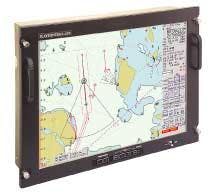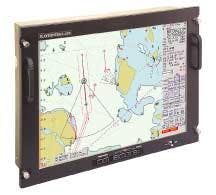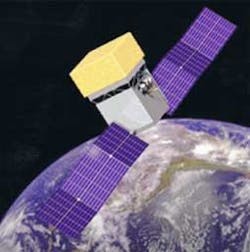Displays
Lockheed Martin chooses Aydin for Tomahawk missile displays
Systems designers at the Lockheed Martin Management and Data Systems division in Philadelphia needed ruggedized commercial off-the-shelf (COTS) displays for the Tactical Tomahawk Weapon Control System — otherwise known as the TTWCS.
The 4420R5C 20.1-inch active-matrix liquid-crystal displays from Aydin Displays Inc. in Birdsboro, Pa., met their needs.
Lockheed Martin designers will integrate Aydin's displays into the missile system's command-and-control equipment, and will be the system's primary operator interface, Aydin officials say.
Lockheed Martin's contract with Aydin is for $7.2 million, and covers several hundred flat-panel displays, company officials say.
The TTWCS supports fire missions for Tomahawk missiles, and provides advanced fire control for the new Tactical Tomahawk missile. The Tactical Tomahawk can execute preplanned fires, en route mission changes, and loitering in the target areas.
The new missile is expandable to support future naval surface warships and submarines, as well as the Expeditionary Warfare Commander's integrated ground fire plans, Aydin officials say.
Aydin's 4420R5C display fits flush in a standard 19-inch rack, has a front bezel that projects only 0.75 inches, features a 9U rack-mount form factor, has standard 5-BNC & HD-15 video connectors, and operates in temperatures from 0 to 50 degrees Celsius.
The display also meets the guidelines of MIL-STD-901D for shock, MIL-STD-167-1 for vibration, MIL-STD-461D for electromagnetic interference, MIL-STD-810E Method 506.3 for moisture resistance, and MIL-STD-810E for sand and dust resistance.
For more information contact Aydin by phone at 610-404-7400, or online at www.aydindisplays.com.
Test and measurement
Navy chooses Racal for shaft engine test instruments
U.S. Navy officials needed shaft engine test instrumentation (SETI) with a test program set for the General Electric T-64, T-58, and T-700 helicopter jet engines. They found their solution from Racal Instruments Inc. in Irvine, Calif.
Navy officials will install Racal's test instrumentation in the A/E37T-24A test cab at Patuxent River Naval Air Station, Md., for Navy and Marine Corps Intermediate Helicopter Engine Test Facilities there.
SETI is based on the primary Navy jet engine test system — the Jet Engine Test Instrumentation (JETI) program. The system uses modular commercial off-the-shelf (COTS) equipment, Racal officials say.
SETI's open-architecture hardware and software enable integrators to create a scalable multivendor system, which Racal officials say will save the Navy money.
SETI will replace a primarily manual test process for the Navy, says Gilbert Guerra, Racal's SETI program manager, adding, "Repeatable test results and automated data capture, reporting, and transfer should result in fuel savings and reduced personnel costs."
For more information contact Racal Instruments by phone at 949-859-2002, or online at www.racalinstruments.com.
Board products
Air Force looks to Space Micro for rad-hard single-board computer
U.S. Air Force researchers needed a radiation-hardened single-board computer for use aboard military satellites. The Proton100k computer from Space Micro Inc. in San Diego met their needs.
Space Micro won a research and development contract from the Air Force Research Laboratory at Wright-Patterson Air Force Base, Ohio, for the company's first satellite computer platform, the Proton100k.
The contract is a phase-2 Small Business Innovative Research contract, which Space Micro won after demonstrating the company's radiation-hardening technology called Time-Triple Modular Redundancy, or TTMR, company officials say.
Space Micro experts say they will eventually integrate TTMR into the Proton100k computer board to offer it as a standard product. The Proton100k provides 2,400 million instructions per second (MIPS) uncorrected throughput and 1,440 MIPS at single-event upset (SEU) rates.
TTMR technology combines low power, high speed, and SEU mitigation with 8 watts for the entire computer. The new board will be able to survive total-dose radiation of more than kilorads, with no single-event latchup, company officials say.
For more information contact Space Micro by phone at 858-487-9295, or online at www.spacemicro.com.
Computers
CMC upgrades avionics computers on Qantas passenger jetliners
Officials of Qantas Airways in Melbourne, Australia, needed avionics upgrades for their fleet of Boeing 747-300 jumbo jetliners. They found their solution from CMC Electronics in Ville Saint-Laurent, Quebec.
CMC acted as overall program manager and system integrator, and supplied the company's Global Positioning system-based CMA-900 flight management system, as well as the company's CMA-2102 high-gain satellite communications antennas.
Although CMC will be finished with the Qantas 747 fleet over the next 18 months, the airline has put the first of six upgraded 747-300s in service.
The Qantas configuration is a multisensor system based on an integrated triple CMA-900 flight management system, as well as triple inertial reference systems and electronic horizontal situation indicator. This setup offers seamless navigation from takeoff landing using vertical navigation guidance for non-precision approaches, CMC officials say.
The CMA-900 also has a color liquid-crystal multifunction display and 12-channel Global Positioning System sensor.
The CMA-900 crew interface is design for commonality with the Boeing 747-400o flight management system, and installing the color multifunction control and display unit in the aircraft forward pedestal leaves space for electronic flight instrument systems if airlines prefer that upgrade, CMC officials say.
For more information contact CMC Electronics by phone at 514-748-3148, or online at www.cmcelectronics.ca.
Test and measurement
U.S. government looks to Lenox Instrument for borescopes
Officials of the U.S. General Services Administration (GSA) in Washington, D.C., needed a line of borescopes, videoscopes, and other visual inspection equipment for a variety of applications. Test and measurement equipment from Lenox Instrument Co. in Trevose, Pa., met their needs.
GSA awarded Lenox a federal supply multiple award schedule contract, which enables federal employees and other eligible users to buy Lenox borescopes easily and at a discount, Lenox officials say.
Lenox makes remote visual-inspection equipment, including rigid/sectional borescopes, fiberscopes, videoscopes, and related accessories, for applications such as engine inspection, law enforcement, aircraft and motor pool maintenance, armament, building inspection, and manufacturing.
For more information contact Lenox by phone at 215-322-9990, or online at www.lenoxinst.com.
Navigation equipment
Taiwan chooses KVH TACNAV system for amphibious assault vehicles
Leaders of United Defense LP in Santa Clara, Calif., needed light tactical navigation systems for new AAV-7 amphibious combat vehicles for the Republic of Taiwan. The TACTAV Light system from KVH Industries in Middletown, R.I., met their needs.
KVH has a history as the supplier for AAV-7 navigation systems. The company's first military vehicle contract was to supply the KVH MV103 digital compass system for the U.S. Marine Corps AAV-7s.
Since then the MV103 Taiwan and the U.S. Marine Corps have fit digital compasses to TACNAV Light unit in use. The units saw action during the Persian Gulf War of 2003.
The KVH TACNAV and fiber-optic gyro products offer combat vehicles 100 percent availability of position and other tactical data, even if signals from the Global Positioning System satellites are blocked or jammed.
KVH builds systems for mobile communications, navigation, and precision pointing through the use of the company's proprietary mobile satellite antenna and fiber optic technologies.
For more information contact KVH by phone at 401-847-3327, or online at www.kvh.com.
Communications equipment
German armed forces chooses radio systems from EADS
Leaders of the German armed forces needed shortwave radio facilities for their new Fennek scout vehicles. Data and voice radios from the European Aeronautic Defence and Space Co. — better known as EADS — met their needs.
EADS Radio Communication Systems GmbG and Co. KG in Ulm, Germany, won a contract supply tactical radio systems from the IT office of the German Armed Forces, EADS officials say.
EADS will supply the HRM 700 radio system, which company officials say is in a position to bridge large distances, and to establish connections automatically.
For more information contact EADS Radio Communication Systems by phone at 011-49-731-392-3681, or online at www.eads.net/eads/en/index.htm?&sysde
Communications equipment
British military chooses General Dynamics for search-and-rescue radios
The United Kingdom Ministry of Defence in London needed combat search-and-rescue radios to help downed pilots communicate with would-be rescuers. The PRC-112G radio from General Dynamics Decision Systems in Scottsdale, Ariz., met their needs.
General Dynamics is providing United Kingdom military leaders with the new radios under terms of an $8 million order. The PRC-112G helps with search-and-rescue operations for the United States, NATO, and other military forces. General Dynamics Decision Systems is a business unit of General Dynamics in Falls Church, Va.
The PRC-112G radio offers encrypted two-way messaging, upgradable software and hardware, embedded Global Positioning System (GPS) capability, direct line-of-sight communications between downed personnel and their rescuers, communication with commercial and national search-and-rescue satellite systems, distance measuring equipment as a backup means of locating downed personnel, and broad communications with unmanned aircraft.
The PRC-112G radio interoperates with other General Dynamics survival radios, which are fielded globally, as well as diverse CSAR interrogator/locator equipment and systems used worldwide.
For more information contact General Dynamics Decision Systems online at www.generaldynamics.com.
Communications equipment
CMC Electronics Cincinnati to provide satellite transmitters
Satellite payload integrators at Spectrum Astro Inc. in Gilbert, Ariz., needed Ku-band transmitters for the National Aeronautics and Space Administration's Gamma-ray Large Area Space Telescope satellite — better known as GLAST.
The GLAST spacecraft, an international project under supervision of the NASA Goddard Space Flight Center in Greenbelt, Md., is to launch in 2006 to study the universe in the energy range of 1,000 to 300 billion electron volts.
CMC's transmitters will provide the primary means of transmitting spacecraft mission data and spacecraft state-of-health telemetry through NASA's Tracking and Data Relay Satellite Network — better known as TDRSS — as well as through ground receiving stations.
CMC's recent spacecraft projects included the High Data Rate X-Band Payload Modulators and Transmitters, TDRSS compatible S-Band Transmitters for launch vehicles, tracking, and telemetry and command (TT&C) transponders with RF and digital circuitry.
For more information contact CMC Electronics Cincinnati online at www.cmccinci.com or by phone at 513-573-6100.






